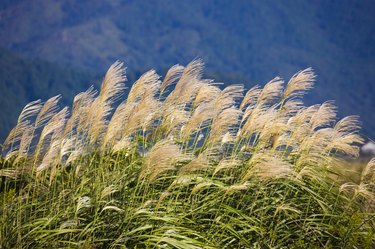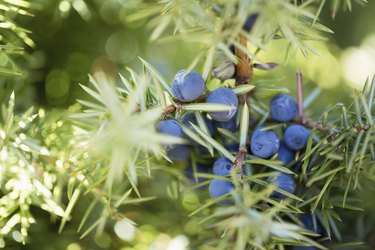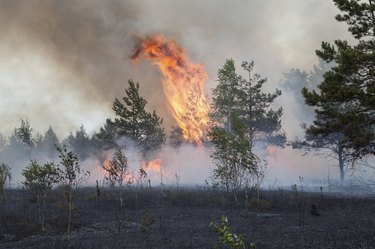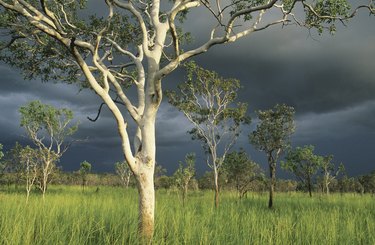
If you live in an area susceptible to wildfires, it's wise to reassess your current landscaping plants and plans. Plants that fuel fires include annual plants, grasses, evergreen shrubs or trees with narrow or thin leaves, and plants that contain resins, oils or waxes. Some native plant communities like chaparral, grasslands and coniferous forests already have a high burn danger. Property owners next to fire-susceptible environments should create a defensible zone around their homes that doesn't invite the spread of fire.
Perennial and Annual Grasses
Video of the Day

With the exception of mown grasses in a well-watered lawn, most grasses, with their slender leaves and accumulation of dried thatch, catch fire easily. Midwestern prairies with their perennial grasses are meant to be swept by fire occasionally to maintain the plant community. Examples of flammable landscaping grasses include pampas grass (Cortaderia selloana), which grows in U.S. Department of Agriculture plant hardiness zones 5b through 11 and fountain grass (Pennisetum setaceum), hardy in USDA zones 9 through 11. Both these grasses can be invasive.
Video of the Day
Coniferous Shrubs

Coniferous evergreen shrubs have slender, dry leaves that contain wax and the branches contain resin. An example is common juniper (Juniperus communis), which grows in USDA zones 2 through 6, and reaches heights of 5 to 10 feet. Eastern arborvitae (Thuja occidentalis) have flat, scale-like leaves and resinous wood. Shrubby cultivars include "Holmstrup," with growth to 10 feet tall and 3 feet wide, globe-shaped "Woodwardii" at 4 to 8 feet tall, and yellow-foliaged "Golden Globe," which reaches 2 to 3 feet tall. Eastern arborvitae grow in USDA zones 4 through 7.
Coniferous Trees

Pine trees (Pinus spp.) emit a pungent aroma due to the resins they contain. Combine this with the fine, thin needles, low-hanging branches and the buildup of dried litter on the ground and fire spreads quickly through the trees. All species of pines, which generally grow in USDA zones 3 through 8, are flammable. Eastern red cedar (Juniperus virginiana) also signals its flammability through pungent resins, scale-like leaves and a pyramidal growth habit with branches to the ground. Growing in USDA zones 2 through 9, trees grow to 40 or 50 feet tall.
Flammable Shrubs

Many drought-tolerant native and exotic plant species catch fire easily because their leaves have a low moisture content and many of them have waxy or resinous properties. Galberry holly (Ilex glabra), which grows in USDA zones 5 through 9 and is native to the eastern and southern United States, is flammable also because bushes tend to grow closely together, which helps fire spread. Aromatic rosemary (Rosmarinus officinalis), hardy in USDA zones 8 through 10, is native to Mediterranean areas. It possesses slender leaves and essential oils that increase its flammability.
Flammable Trees

As Australian wildfires demonstrate, eucalyptus trees (Eucalyptus spp.), which are native to Australia, are highly flammable, with stiff leaves containing abundant essential oils. Many eucalyptus species are available as landscaping plants. A widely grown species, silver dollar gum (Eucalyptus polyanthemos) is hardy to USDA zones 9 through 10. Some kinds of palm trees, such as saw palmetto (Seranoa repens), which grows in USDA zones 8 through 11, or desert palm (Washingtonia filifera), hardy in USDA zones 9 through 11, accumulate dead fronds along the trunk that are flammable. Keep dead fronds pruned from palms to prevent fire spread.
- University of Florida IFAS Extension: Fire in the Wildland-Urban Interface: Selecting and Maintaining Firewise Plants for Landscaping
- Lane County Oregon: Highly Flammable Trees & Vegetation
- University of Florida IFAS Extension: Cortaderia Selloana Pampas Grass
- University of Florida IFAS Extension: Pennisetum Setaceum "Rubrum" Purple Fountain Grass
- University of Illinois Extension: Selecting Shrubs for Your Home: Common Juniper
- National Gardening Association: Arborvitae
- Arbor Day Foundation: Redcedar, Eastern
- Alabama Cooperative Extension System: Hollies for the Landscape in the South
- Missouri Botanical Garden: Rosmarinus Officinalis
- Cal Poly Urban Forest Ecosystems Institute: Silver Dollar Gum
- University of Florida IFAS Extension: Serenoa Repens Saw Palmetto
- University of Florida IFAS Extension: Washingtonia Filifera Desert Palm